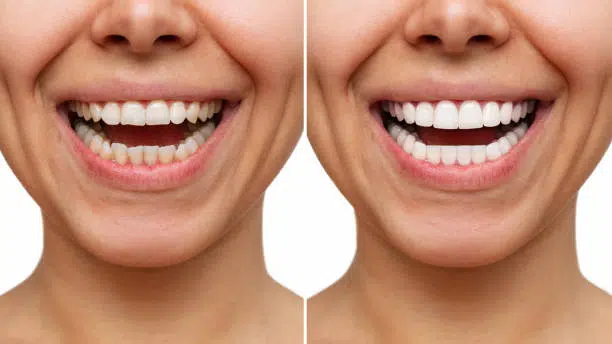Composite veneers represent a significant advancement in cosmetic dentistry, offering patients an opportunity to transform their smiles without extensive tooth reduction. These thin, custom-made shells crafted from dental composite resin are bonded directly to the front surface of teeth, effectively concealing various aesthetic imperfections such as discoloration, chips, gaps, and minor misalignments. Unlike their porcelain counterparts, composite veneers typically require minimal to no enamel removal, preserving more of the natural tooth structure. Clinical studies have demonstrated that when properly applied by experienced practitioners, composite veneers can last 5-7 years while providing natural-looking results that enhance facial aesthetics and boost patient confidence.
Table of Contents
The application of composite veneers involves a meticulous process that combines scientific principles with artistic skill. Dentists apply the composite resin directly to the tooth surface in layers, carefully sculpting and shaping the material to achieve the desired form, translucency, and color. This direct application technique allows for immediate results, often completed in a single appointment, and permits easy repairs should damage occur. The versatility of composite materials has evolved significantly in recent decades, with modern formulations offering improved durability, stain resistance, and optical properties that closely mimic natural enamel. These properties, combined with their relative affordability compared to other cosmetic options, have established composite veneers as a popular solution for patients seeking conservative yet effective smile enhancements.
Composite vs Porcelain Veneers: Comparison Guide
When choosing between composite and porcelain veneers, understanding their fundamental differences is essential for making an informed decision. Both options offer distinct advantages depending on your specific dental needs, aesthetic goals, and budget considerations. Let’s examine how porcelain veneer composite veneer options compare in several key aspects.
| Feature | Composite Veneers | Porcelain Veneers |
|---|---|---|
| Material | Resin-based composite | Medical-grade ceramic |
| Cost | $250-$1,500 per tooth | $925-$2,500 per tooth |
| Durability | 5-7 years | 10-15+ years |
| Appearance | Good aesthetics, less translucent | Superior aesthetics, highly natural |
| Stain Resistance | Moderate, may discolor over time | Excellent, highly resistant |
| Repair | Easily repairable | Typically require replacement |
| Preparation | Minimal tooth reduction | More extensive tooth preparation |
| Treatment Time | Single visit (typically) | Multiple visits (2-3) |
This comparison highlights the primary differences between these two popular veneer options. While porcelain veneers offer superior aesthetics and longevity, composite veneers provide a more affordable and less invasive alternative.
What are resin veneers exactly? Composite resin veneers consist of a tooth-colored filling material directly applied to the tooth surface. They’re sculpted, hardened, and polished to create a natural appearance. Understanding what composite resin veneers involve can help patients determine if they’re suitable for their needs.
Key characteristics of composite resin veneers include:
- Versatility: Can address minor to moderate cosmetic concerns including chips, gaps, and discoloration
- Conservativeness: Require minimal or no removal of natural tooth structure
- Adaptability: Can be adjusted or enhanced during future dental visits
- Affordability: Significantly less expensive than ceramic alternatives
- Immediate results: Typically completed in a single dental appointment
When considering which is better, veneers or composite, the answer depends on your specific circumstances. Porcelain veneers excel in creating a premium aesthetic result with exceptional durability and color stability. Composite resin veneers offer an economical solution that delivers good cosmetic improvement while preserving more natural tooth structure.
What are composite resin veneers best suited for? They’re ideal for patients seeking affordable cosmetic enhancement, those with minor imperfections, younger patients whose teeth are still developing, and individuals wanting to “test drive” a smile makeover before committing to permanent options. The dental industry continues to advance composite materials, improving their performance and aesthetics while maintaining their cost advantage over porcelain alternatives. This makes composite veneers a popular choice for those researching options, as the How Long Do Veneers Last Guideexplores, shedding light on what are composite veneers among other types. As technology continues to improve, patients can expect even better results and durability from these materials.
Composite Veneers Application Methods and Outcomes
Composite veneers represent a versatile cosmetic dentistry solution for transforming smile aesthetics. These tooth-colored restorations are applied to the front surface of teeth to enhance appearance while preserving natural tooth structure. Let’s explore the different application techniques and their expected outcomes.
Direct Composite Veneer Application
The direct composite veneer technique involves applying composite resin material directly to the tooth surface in a single dental visit. This method offers immediate results and typically requires minimal tooth preparation.
- Tooth preparation begins with cleaning and slight roughening of the enamel surface to improve bonding.
- The dentist selects appropriate composite shade that matches surrounding teeth.
- A bonding agent is applied to the prepared tooth surface.
- The composite resin material is carefully layered onto the tooth.
- Each layer is shaped and hardened using a special curing light.
- The dentist sculpts and contours the composite material to achieve the desired shape.
- Final polishing creates a natural-looking surface texture and shine.
- Immediate visual transformation of tooth appearance
- Natural-looking results with appropriate color matching
- Same-day completion without temporary restorations
- Conservative approach preserving more natural tooth structure
- Repairable if damage occurs in the future
What are direct composite veneers? They are hand-crafted restorations built directly on the tooth surface by a skilled dentist. The composite veneers procedure using the direct method allows for artistic customization in a single appointment, making it ideal for patients seeking immediate smile enhancement.
Indirect Composite Veneer Application
Indirect composite veneers involve a multi-step process where pre-designed composite veneers are fabricated outside the mouth before being bonded to the teeth. This technique offers exceptional precision and durability.
- Comprehensive examination and smile assessment to determine treatment goals.
- Minimal tooth preparation with precise reduction of enamel.
- Digital or traditional impressions are taken of the prepared teeth.
- Temporary veneers may be placed while custom veneers are being fabricated.
- Laboratory technicians create custom-designed veneers using high-quality composite materials.
- The fabricated veneers are tried in to verify fit, color, and appearance.
- Final bonding procedure permanently attaches the veneers to the prepared teeth.
- Final adjustments ensure proper bite alignment and comfort.
- Highly precise fit due to laboratory fabrication
- Exceptional esthetic results with multiple composite layers
- Superior surface finish achieved in controlled lab environment
- Consistent appearance across multiple teeth
- Predictable outcomes based on pre-approved designs
What composite veneers look like depends largely on the skill of both the dentist and laboratory technician. Composite veneers treatment using the indirect method delivers remarkably natural-looking results that blend seamlessly with existing teeth. What are composite veneers made of? They utilize advanced resin materials reinforced with glass particles for strength and optical properties that mimic natural enamel.
The composite veneers before and after transformation is often dramatic, addressing issues such as discoloration, minor misalignment, gaps, and irregularly shaped teeth. What is a composite veneer for teeth? It’s essentially a thin shell of tooth-colored material that covers the visible portion of a tooth, creating an immediate esthetic improvement while maintaining a natural appearance.
Composite Veneers Longevity and Limitations
Understanding what is the downside of composite veneers and their expected lifespan is crucial for patients considering this dental treatment option. Composite veneers offer numerous benefits but come with specific limitations and durability concerns that should be thoroughly evaluated before proceeding with treatment.
- Average lifespan of 5-7 years: While properly maintained composite veneers can function well for several years, they typically don’t last as long as porcelain alternatives. How long do composite veneers last depends significantly on oral hygiene practices and lifestyle habits.
- Susceptibility to staining: Composite materials are more porous than other veneer options, making them vulnerable to discoloration from coffee, wine, tobacco, and highly pigmented foods.
- Surface changes over time: Composite veneers after 5 years often begin showing signs of wear, including microscopic roughening of the surface that can collect stains more readily than when first placed.
- Material degradation: The resin material gradually breaks down when exposed to saliva, leading to marginal discoloration where the veneer meets the natural tooth.
- Potential for chipping and fractures: Composite materials lack the structural integrity of ceramics, making them more prone to damage from biting hard foods or objects.
- Maintenance requirements: Regular professional polishing every 6-12 months is necessary to maintain appearance and extend longevity.
- Replacement necessity: Most patients require complete replacement rather than repair once significant wear occurs.
- Appearance changes: Composite veneers after 10 years typically show noticeable color changes, with margins becoming more visible and surface luster diminishing considerably.
- Edge wear: The thin edges of composites can wear down over time, creating visible transitions between the veneer and natural tooth structure.
- Bonding deterioration: The adhesive bond between tooth and composite may weaken over extended periods, potentially leading to microleakage and secondary decay.
- Material limitations: Composite veneers cannot withstand the same functional stresses as natural teeth, requiring lifestyle modifications to preserve their integrity.
- Technique sensitivity: The quality and longevity of composite veneers vary significantly based on the clinician’s skill and attention to detail during application.
Patients should understand that while composite veneers represent an excellent intermediate cosmetic solution, they are not permanent. Regular dental examinations are essential for monitoring the condition of veneers and planning timely replacement when signs of deterioration become evident. Most dental professionals recommend reassessment at the 5-year mark to evaluate whether maintenance or replacement is appropriate.
Composite Veneers Service Locations
Across the United Kingdom, composite veneers have become increasingly accessible through a network of specialized clinics and dental practices. These aesthetic dental solutions are available in various locations, with particular concentration in metropolitan areas where demand for cosmetic dentistry is highest.
- London Harley Street Dental District – Home to some of the UK’s most prestigious cosmetic dentistry clinics offering premium composite veneers London services. These clinics frequently serve celebrity clientele and individuals seeking high-end treatments with experienced practitioners who have performed thousands of veneer applications.
- Central London Dental Practices – The West End, Kensington, and Chelsea areas host numerous established practices specializing in composite veneer treatments with competitive pricing structures. Many offer free consultations for patients considering composite veneers UK options.
- Greater London Dental Clinics – Areas such as Croydon, Bromley, and Richmond provide more affordable composite veneer treatments while maintaining high standards of care. These clinics often employ dentists trained at leading UK dental schools.
- Regional Cosmetic Dentistry Centers – Major cities including Manchester, Birmingham, Edinburgh, and Glasgow feature specialized cosmetic dentistry practices. These centers frequently offer what are composite veneers UK educational sessions for prospective patients.
- University-Affiliated Dental Hospitals – Several UK dental schools provide composite veneer services at reduced rates while supervised by senior clinicians, making aesthetic treatments more accessible to budget-conscious patients.
- Chain Dental Practices – Nationwide dental groups have expanded their composite veneer offerings across multiple UK locations, standardizing treatment protocols and pricing structures.
- Mobile Dental Services – Some practitioners now offer mobile composite veneer services, particularly in rural areas where specialized cosmetic dentistry may be less accessible.
Finding quality composite veneers London specialists requires research, as the concentration of providers varies significantly by region. The highest density of specialized cosmetic dentists remains in London, particularly in Harley Street and surrounding areas, though the availability of skilled practitioners offering composite veneers UK services continues to grow nationwide, making these treatments increasingly accessible regardless of location.



